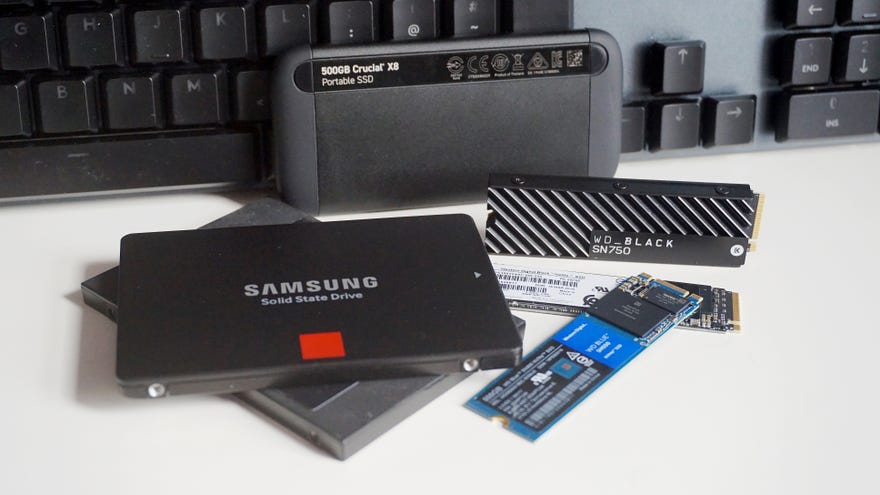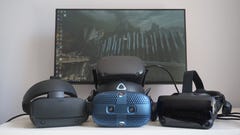Best SSD for gaming 2023: our top SATA and NVMe drives
Our top solid state drive recommendations
Fret not, late adopters – this guide to the best SSDs for gaming isn’t liable to takeover by cutting-edge PCIe 5.0 drives anytime. The latest NVMe SSD interface may become the norm in the future, but right now it remains too narrowly supported by CPUs and motherboards, keeping PCIe 3.0 and 4.0 SSDs as your most easily available options. More importantly, the first 5.0 SSD I’ve had the chance to test – the Crucial T700 – isn’t even reliably faster than the best PCI 4.0 SSDs, while costing a hell of a lot more. No thank you.
Yes please, on the other hand, to these SSDs below. They’re all here because they’ve impressed in our suite of benchmark tests, which include a Shadow of the Tomb Raider loading challenge to really see how well they work in a gaming PC specifically. And it’s not just NVMe models, either: we're also including some top SATA and external/USB SSDs so that all your possible storage needs will be met. Except maybe if you need a microSD card for your Steam Deck, but we have a guide for that too. Naturally.
Gaming SSDs have come a long way from the luxuries they once were. Nowadays they should absolutely be the core of your rig’s storage setup, and while you can use mechanical HDDs for backup capacity, SSD prices have fallen to the point where it’s easily possible to have an all-solid-state setup. Nab yourself a 1TB NVMe model and you may not feel the need for secondary drives at all.
Granted, installing an SSD won’t make your games run faster – a graphics card upgrade would be more appropriate for that. But they can potentially load faster, as can Windows and all your other apps, allowing for more time spent playing and less time staring at progress bars and blank screens.
Best SSD for gaming 2023
- WD Blue SN570 - the best NVMe SSD for gaming
- WD Black SN850X - the best PCIe 4.0 NVMe SSD for gaming
- Lexar NM790 - the best cheap PCIe 4.0 SSD for gaming
- Samsung 990 Pro - the best PCIe 4.0 NVMe SSD for shorter loading times
- Crucial P3 - the best SSD for pure PCIe 3.0 speed
- Samsung 870 Evo - the best SATA SSD for gaming
- Samsung 870 Qvo - the best big SATA SSD for gaming
- WD Black P40 - the best external SSD for gaming
- Samsung T7 Shield - the best rugged external SSD for gaming
- Kingston XS2000 - the best USB 3.2 2x2 external SSD for gaming
WD Blue SN570
The best NVMe SSD for gaming

You could also call this the best cheap NVMe SSD for gaming, as the WD Blue SN570 follows its predecessors – the SN500 and SN550 – in targeting a lower-than-average price. You wouldn’t know this was an affordable model from the performance, though: the 1TB model I tested easily lived up to its official maximum sequential speeds, and its random read speeds (the most important for gaming performance) could outpace high-end Samsung and WD SSDs too. That includes the (former) flagship WD Black SN750.
Not that it’s the absolute fastest NVMe SSD we’ve ever tested, but that doesn’t change the fact that the SN570 is wonderfully agile by both budget-friendly and general PCIe 3.0 standards. Its write speeds hold up especially well in tough workloads, so it’s a great all-rounder too, and the single-sided design will help it fit into cramped laptops as well as desktop PCs.
What we like:
✔️ High speeds, both for reads and writes
✔️ Very affordable
✔️ Decent choice of capacities
Read more in our WD Blue SN570 review
WD Black SN850X
The best PCIe 4.0 NVMe SSD for gaming
That little ‘X’ makes the WD Black SN850X look like a mere refresh of the Black SN850. But it’s more of an wide-reaching overhaul than it appears, with higher sequential read/write speeds, faster IOPS (input/output performance), controller improvements, and even a new 4TB model.
Most importantly, the SN850X is much faster in games, and faster than every other SSD we’ve tried outside of the Samsung 990 Pro below. Taking only 6.7 seconds to load a Shadow of the Tomb Raider save, it shaves nearly three seconds off the Black SN850’s time, and clearly beats other premium PCIe 4.0 SSDs like the Kingston Fury Renegade (9.6 seconds) and PNY XLR8 CS3140 (7.3 seconds). In the CrystalDiskMark benchmark, its 3187MB/s random read speed and 4261MB/s random write speed results show an outstanding suitability for games and general PC usage alike.
It's a shame there’s no longer a cheaper 500GB option, as there was for the Black SN850, but the 1TB and 2TB are at least less expensive than the 990 Pro equivalents.
What we like:
✔️ Outrageously fast
✔️ Not too expensive (by high-end standards)
✔️ 4TB option
Lexar NM790
The best cheap PCIe 4.0 SSD for gaming
One good reason to hold off upgrading to PCIe 5.0 is the recent emergence of cheap PCIe 4.0 SSDs. These are perfect for out-speeding older drives without burning through budget that could go elsewhere on your PC build, and there are several tasty options. My current pick of these is the Lexar NM790, which is indeed affordable while delivering performance close to that of high-end PCIe 4.0 models like the WD Black SN850X.
I tested the 1TB capacity, which claims lofty 7400MB/s read speeds and 6500MB/s write speeds. It only reached that level of cor-blimey quickness in largely academic sequential file transfer benchmarks, but was extremely impressive in CrystalDiskMark’s 4K random tests, averaging 3499MB/s reads and a 3117MB/s writes. The Crucial P3 Plus, the previous holder of this cheap PCI 4.0 spot, 'only' managed 1690MB/s reads and 3118MB/s writes.
The NM790 also put the P3 Plus to the sword in AS SSD’s copy benchmarks and our load speed test. It was more than twice as fast at copying game files, scoring 3275MB/s to the Crucial SSD’s 1368MB/s, and it loaded up Shadow of the Tomb Raider in 7s flat – 0.3s ahead of the P3 Plus. You can find the latter for even less money, but the NM790’s premium performance makes it an even better buy.
What we like:
✔️ PCIe 4.0 at a low price
✔️ High read speeds ideal for gaming PC
✔️ Three capacity options
Samsung 990 Pro
The best PCIe 4.0 NVMe SSD for shorter loading times
The Samsung 990 Pro comes achingly close to being the best PCIe 4.0 SSD outright, but its steep launch prices make the WD Black SN850X a better deal. Nevertheless, here’s what you get for your money if you do decide to go for the Samsung: exceptional read speeds in both light and heavy loading/copying tasks, and record-setting gaming performance.
In the CrystalDiskMark random read/write test, which is more representative of real-life speeds than sequential figures, the 990 Pro shot to 3647MB/s read and 4090MB/s write results. The former, in particular, is about 2000MB/s quicker than the very best PCIe 3.0 drives have managed, not to mention over 1100MB/s faster than the old Samsung 980 Pro. And because better read speeds equal better load times, the 990 Pro launching a Shadow of the Tomb Raider save in 6.6 seconds makes it the fastest we have on record.
As such, it definitely deserves a place on this list, and is arguably worth the big outlay if you’re speccing for a high-end gaming PC. A sale wouldn’t hurt, mind.
What we like:
✔️ Best-in-class load times
✔️ Superb read/write speeds for general use
✔️ Optional heatsink (tested without)
Crucial P3
The best SSD for pure PCIe 3.0 speed
Even it doesn’t match the WD Blue SN570 on overall value, there’s still a good reason to choose the Crucial P3 instead: in certain scenarios, it’s the outright fastest PCIe 3.0 SSD we’ve tested.
Like its PCIe 4.0 cousin, the P3 Plus, the P3 is a particularly pacy writer, even outperforming some 4.0 SSDs with its CrystalDiskMark write speed result of 3022MB/s. But it’s also impressively effective in the kind of tricky read tasks that games rely on, as seen in its excellent AS SSD 4K read speed of 57.9MB/s. When the time came to load up Shadow of the Tomb Raider, it did so in just 7.5s, a mere fraction of a second slower than the P3 Plus' 7.3s – and faster than any other PCIe 3.0 SSD so far.
If you’ve yet to upgrade to a PCIe 4.0-ready setup, then, the Crucial P3 is more or less the next best thing.
What we like:
✔️ Immense speeds for its interface
✔️ Widely compatible
✔️ Still not too pricey
Samsung 870 Evo
The best SATA SSD for gaming
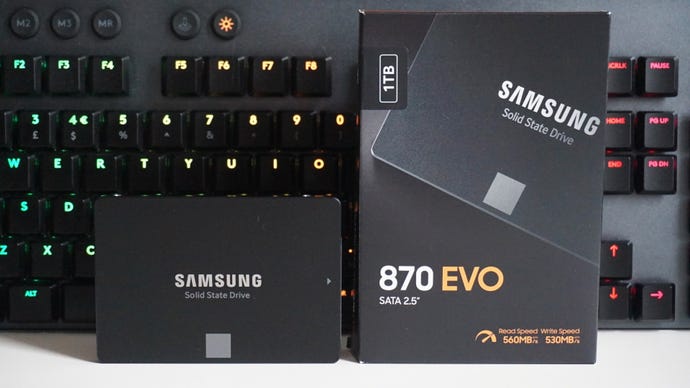
When it comes to buying an SSD for gaming, a lot people still opt for a 2.5in SATA drive rather than a super fast NVMe SSD, if only because the latter tend to be quite expensive and you need a motherboard that supports them. For SATA SSD hunters, then, the Samsung 870 Evo is hands down the best drive for the job right now. Its everyday speeds aren't that much faster than its predecessor, the 860 Evo, but with that drive becoming increasingly difficult to get hold of, the 870 Evo is now our SATA SSD of choice for those.
In fairness, Crucial's MX500 is another good budget option for SATA buyers, but when prices for the 870 Evo are only a fraction more these days, there's little point opting for the MX500 unless you can find it for a substantial discount. What's more, the 870 Evo also comes with a much higher endurance rating than the MX500: 300 terabytes written (TBW) for the 500GB model as opposed to just 180TBW on the 500GB MX500. It's fast, durable, and yet to be beaten on overall value.
What we like:
✔️ The fastest SATA drive you can buy today
✔️ Great endurance levels
✔️ Better value for money than the competition
Read more in our Samsung 870 Evo review
Samsung 870 Qvo
The best big SATA SSD for gaming

In fact, there is one SSD with faster write speeds than the Samsung 860 Evo, and that's Samsung's 870 Qvo. Made from 4-bit MLC V-NAND instead of 3-bit MLC like its Evo counterparts, the 870 Qvo is much better value than Samsung's equivalent Evo drives. Its performance is more or less identical, and it's a heck of a lot cheaper, too. As such, if you're looking to get an SSD that's at least 1TB in size but don't want to fork out loads of cash (either on an expensive NVMe SSD or a high capacity SATA drive), the 870 Qvo is the way to go.
Like the rest of Samsung's drives, the 870 Qvo has exceptional endurance ratings and warranties, and its random read and write times are up there with the very best. Plus, if you've got enough cash, you can buy one that's a whopping 8TB - which is practically unheard of in SATA circles. It's still not as cheap as buying a large hard disk drive, but it's the best you're going to get on an SSD.
What we like:
✔️ Excellent everyday performance
✔️ Brilliant value for money
✔️ Just as fast as Samsung's Evo SSDs
Read more in our Samsung 870 Qvo review
WD Black P40
The best external SSD for gaming
Just between us, readers, I needed a long, hard think about whether to replace the Crucial X8 on this list with the WD Black P40. Both are exceptionally fast external SSDs, especially over a USB 3.2 Gen 2 connection, and the older X8 actually has a read speed edge in a few tests. Still, the Black P40 earns its place here, thanks in part to consistently quicker write speeds and markedly better results in AS SSD’s file copy benchmark.
This simulates how long it would take to transfer copies of various files to the drive, much like if you were backing up games installs. In fact, the benchmark has a ‘Game’ portion specifically, and the Black P40’s 435.2MB/s result in it walks all over the X8’s 278.2MB/s.
WD’s drive is also slightly more compact, if only by a matter of millimetres, and offers a smidge of extra design flair through RGB lighting strips on the underside. These don’t undermine durability, thankfully, as the Black P40 still survived a few not-entirely-unintentional drops to my floorboards.
What we like:
✔️ Very fast
✔️ Practical design, with or without RGB
✔️ Includes USB-A adapter
Samsung T7 Shield
The best rugged external SSD for gaming
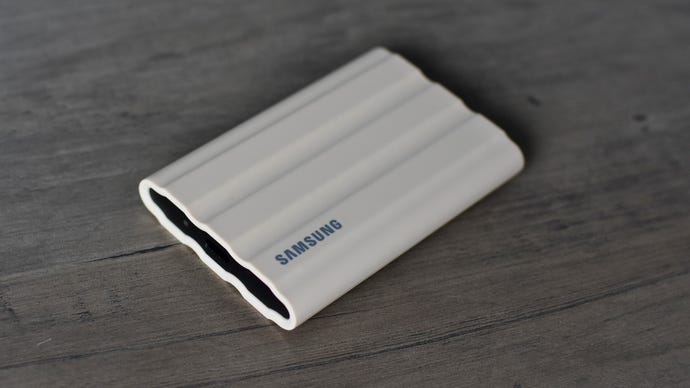
It would be unfair to call the Samsung T7 Shield merely a more ruggedised, fingerprint sensor-less take on the T7 Touch. Besides launching with much more sensible (albeit still relatively high) pricing, the T7 Shield outran the T7 Touch in every single one of our usual performance tests. That includes the AS SSD benchmark’s ISO and application copying tests, which are especially relevant to external drives: to give just one, the T7 Shield scored 332MB/s in the game copying test, easily besting the T7 Touch’s 249MB/s.
The WD Black P40 is faster and the Kingston XS2000 is more compact, but it’s still worth paying for the T7 Shield’s added toughness if you want something that will regularly get stuffed in a backpack. Its rubbery exterior adds some drop protection and even with a detachable cable, the T7 Shield is water- and dust-resistant to the IP65 standard: enough for a total blockage of dust and dirt ingress, or to withstand an accidental drinks spillage.
What we like:
✔️ High speeds
✔️ Durable but lightweight design
✔️ Both USB-A and USB-C cables included
Kingston XS2000
The best USB 3.2 2x2 external SSD for gaming
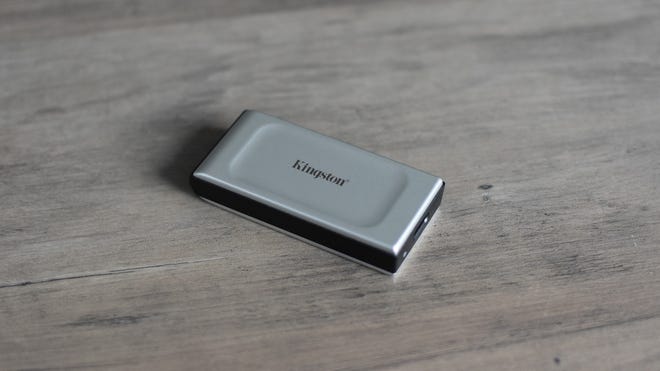
Portable SSDs are tied up in a lot of silly naming conventions for USB standards, like how “USB 3.2 Gen 1” is basically just USB 3.1. All you need to know about USB 3.2 2x2 is that it’s the fastest USB standard you can currently expect to find supported by gaming motherboards, at least until USB4 adoption picks up.
Granted, even USB 3.2 2x2 mobos are still pretty rare, and I don’t recommend the Kingston XS2000 if you’re going to limit it to lower USB 3.2 Gen 2 speeds. But if you do have 2x2 hardware, you’re in for a treat, as this wonderfully pocket-friendly SSD can more than match its advertised sequential speeds while flying through more challenging read and write tasks. In the AS SSD copy benchmark, it completed the game copying portion in 1.21s, or at 1138MB/s; the Crucial X8’s best showing, over USB 3.2 Gen 2, was 3.3s / 420MB/s.
What we like:
✔️ Exceptionally fast over USB 3.2 2x2
✔️ Very small and light
✔️ Bundled with protective sleeve
Frequently asked questions
SATA SSD vs NVMe: what's the difference?
SSDs are split into two main types right now: SATA drives and NVMe drives. 2.5in SATA SSDs are the easiest drop-in replacement for a standard hard disk. These plug into a SATA 3 port on your motherboard, and most modern PC cases have mounting points for 2.5in SSDs on the back of the motherboard tray. If yours doesn't, you can use a cheap adaptor (really just a 3.5in-wide metal plate with screw holes) to fit the SSD in a normal 3.5in hard disk bay. The SATA 3 interface has been around since 2009. It's several times faster than a mechanical hard disk, but it's also not really quick enough to keep pace with the very fastest SSDs that are around today.
If you're in the market for a super-fast SSD that won't be encumbered by its interface, you need to move beyond SATA to NVMe (also called PCI Express, PCIe NVMe, or just NVMe). Most NVMe SSDs are are just 22mm wide and 80mm long (so about a third shorter than a stick of RAM) and are mounted directly to the motherboard in an M.2 slot, so no more having to route SATA and power cables around your case. If your motherboard doesn't have such a slot, there's only one way to unleash the speed: a PCIe add-in card (AIC). These add-in cards will fit in a spare PCIe x4 or x16 slot and are monstrously quick, as well as monstrously expensive.

What's the difference between PCIe 3.0 and PCIe 4.0 SSDs?
Like many different kinds of technology, the PCI Express (PCIe for short) interface has had many different generations over the years. Most new CPUs and motherboards these days provide PCIe 4.0 support, though PCIe 3.0 is still very widely used, hence why 3.0 SSDs are still releasing. The main difference between them is the amount of bandwidth they have to move data back and forth between different parts of your PC.
Bandwidth doubles every generation. PCIe 3.0 currently has a bandwidth of 32GB/s, as well as a bit or data rate of 8 gigatransfers per second (GT/s). However, PCIe 4.0 doubles that to a bandwidth of 64GB/s and a bit rate of 16 GT/s, making it much, much faster at moving large quantities of data around.
What size SSD should I buy?
The minimum SSD size I'd recommend these days is 500GB, as this will give you enough room for your Windows installation (around 20GB), a few big games, plus all your music, photos and any other programmes you might need. However, if you have a particularly large photo and music collection, or just like having lots of games installed at the same time, then I'd recommend bumping it up to the 1TB mark.
To get the most gigs for your money, you could get a smaller SSD - even as little as 256GB - as your main drive and augment it with a 1TB or 2TB hard drive. Just remember, though, that any games or apps saved on the HDD won't benefit from the SSD's much faster speed. I'd still suggest going for the biggest SSD that your budget will allow.
